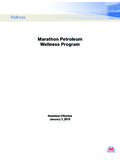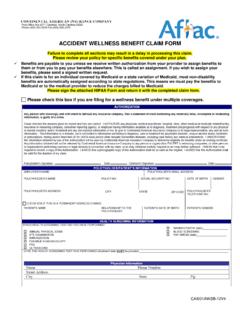Transcription of An Employer’s Guide to Workplace Emotional …
1 20 F Street, NW, Suite 200 Washington, 20001 Fax Creative wellness Benefits Solutions for Today, Strong Policy for Tomorrow An Employer s Guide to Workplace Emotional wellness June 2011 2 3 An Employer s Guide to Workplace Emotional wellness 1 Executive Purpose of the Guide .. Summary of Key Employer Future Opportunities .. 2 Defining Emotional Workplace Emotional wellness .. 3 Business Case for Workplace Emotional wellness .. Goals for Workplace Emotional Business Impact for Workplace Emotional Benefits and Risks of Workplace Emotional 4 Primary Factors Influencing Workplace Emotional Organization Organizational Change 5 Employer Solutions for Workplace Emotional wellness .. Workplace Emotional wellness Strategies and Workplace Emotional wellness Programs, Services, and Culture Workplace Emotional wellness Policies and 6 Bibliography.
2 7 References .. 4 Acknowledgements This Guide is the result of collaboration between the National Business Group on Health and the Center for Mental Health Services, Substance Abuse and Mental Health Services Administration. Many individuals and organizations contributed to the development, authorship, and review of this toolkit. Without this commitment and dedication of these individuals and organizations, the implementation toolkit would not have been completed. Contributing Staff from the National Business Group on Health Krissy Kraczkowsky, MPH, MBA Author Demian Kendall Analyst Elisabeth Meinert Analyst Ronald A. Finch, EdD Principal Investigator Contributing Consultants Scott Rothermel, Principal Rothermel & Associates, Inc Author Contributing Staff from the Center for Mental Health Services Bill Hudock, MA, Special Expert Financing Policy Center for Mental Health Services, Substance Abuse and Mental Health Administration 5 Advisory Board Members Gene Baker OptumHealth David Ballard American Psychological Association Richard Bedrosian, Health Media, Inc.
3 Allison London Brown Healthways Ambyr Brooks University of Michigan Daniel J. Conti, JPMorgan/Chase Dee Edington, University of Michigan Jack Groppel HPI Institute Bill Hudock Center for Mental Health Services Substance Abuse and Mental Health Administration Ann Kuhnen, MD GlaxoSmithKline Dan Prewitt Healthways Duane Putnam Pfizer Gregg Gittus Health Media, Inc. Allan Kennedy AT&T Janice Lenehan Johnson & Johnson Lyle Miller, Biobehavioral Institute Pamela Greenberg Association for Behavioral Health and wellness Scott Rothermel Rothermel & Associates Inc. Robert Rosen, Healthy Companies, International Steven Sauter, National Institute for Occupational, Safety, and Health Mark Smith Healthy Companies, International Don Weber PricewaterhouseCoopers Steve Xenakis, Retired Department of Defense Susan Hagen University of Michigan 6 Citation and Reproduction An Employer's Guide to Workplace Emotional wellness was generously funded by a grant from the Department of Health and Human Services, Substance Abuse and Mental Health Administration, Center for Mental Health Services.
4 All materials are in the public domain. When referencing the implementation toolkit, please use the following citation: Finch, RA and Kraczkowsky, K, editors. An Employer s Guide to Workplace Emotional wellness . Washington, DC: Center for Prevention and Health Services, National Business Group on Health; 2010. All materials in this toolkit are available online at: 7 1 Executive Summary Business executives know the long term success of a company depends heavily upon the sustained productivity of its people. What not enough executives fully value, or have yet to act upon, is that the strategic definition of organizational assets should extend to humans, not just capital. More importantly, actively investing in a company s human assets, including its employees physical, mental and Emotional health, is just as vital as maintaining its machinery, supply chain and customer relationships.
5 Some argue employee Emotional health is too soft for employers to directly support; this Guide is intended to address these business concerns and will provide recommendations to help employers strategically address employee Emotional health. Executives and senior management are seeing the impact of this oversight or neglect as the cost of health care continues spiral out of control. Total health care expenditures are approaching $ trillion, which represents nearly 16% of the country s gross domestic product. A 2008 Health Care Cost Survey, showed companies are paying an average of over $9,000 per employee for health care. In 2006, corporate health care costs represented of total benefit costs compared to of total benefit costs in In addition to addressing the cost of health care, the current economic crisis has intensified the focus on productivity, with organizational leaders understanding that increasing and maintaining employee productivity will be essential to meeting shareholder expectations.
6 Additionally, the aging of the workforce and employees, who are choosing to remain in the Workplace past traditional retirement age, will require everyone in management to seek a new understanding and creative approaches to achieving organizational productivity objectives. Some employers are exploring new concepts that focus on the total value of health, and culture of health to help achieve corporate objectives. These companies are beginning to realize that success includes improving and maintaining employee and dependent health status. These success factors include: Improving the health status of the workforce. The issue is not what it costs to keep people healthy and productive, rather what it costs to let them remain unhealthy. Providing financial and other incentives that encourage the use of high value and proven preventive practices and interventions, and discouraging use of wasteful or unproven services.
7 Aligning economic and behavioral incentives for health care providers, employers, suppliers and consumers to increase the value and sustainable impact of these services. 8 Empowering employers, purchasers, intermediaries, providers, and individuals with shared, clear roles of responsibility and accountability for health and resulting productivity. Using broad metrics that go beyond medical costs and focusing on improving health status. Measuring the full return on investment from increased productivity as well as medical costs and savings from continually improving the health status of the workforce. To achieve their strategic business objectives, employers must create an environment that encourages employees to maintain their total health: physical, mental, Emotional and spiritual. Dee Edington, writing in Zero Trends, has outlined five strategies of change that will help organizations develop a culture of health and achieving health and productivity goals.
8 These strategies include changing: 1. From health as the absence of disease to health as vitality and energy; 2. From only caring for the sick to enabling health people to stay healthy; 3. From the cost of healthcare to the total value of health; 4. From individual participation to population engagement; and 5. From behavior change to a culture of health. ii In order to control costs and promote health, employers are offering expanded benefits, including employee assistance, health promotion and disease management programs. Of these, health promotion programs are the only programs designed primarily to prevent poor health. These programs target common risk factors of chronic diseases including tobacco use, physical activity and diet. Rarely do these programs extend beyond physical health and target behavioral health or Emotional health issues, even though these issues contribute significantly to the health and productivity of employees.
9 To achieve a meaningful culture of health, company policies, business practices, and communication methods must support positive Emotional health and not contribute to poor health. Achieving emotionally healthy employees requires organizational leadership and a corporate culture that values Emotional health. Purpose of the Guide The purpose of this Guide is to educate employers about the business association between organizational practices, personal resilience and the Emotional health of its employees and 9 dependents. The Guide includes actionable strategies and recommendations that will enable employers to create a work environment and related programs that promote Emotional health. This purpose will be accomplished by exploring organizational practices that contribute to individual stress, depression, and anxiety.
10 The Guide will also explore preventive mental health services that can be offered through the health benefits plan, disability management, and employee assistance as well as health promotion/ wellness programs. The Business Group believes that by identifying common organizational stressors, implementing effective programs and using targeted communication practices, employers can be more proactive at improving the Emotional health of their employees and dependents. Approach The Business Group convened the National Committee on Workplace Emotional wellness (NCWEW) to develop recommendations for the design, quality assurance, structure, and integration of programs and services of Workplace Emotional wellness . The Committee consisted of 25 health and wellness benefits experts, health and productivity professionals, and representatives from managed care and managed behavioral health organizations, pharmacology experts, academic researchers, health care consultants, and benefit managers and medical directors.






